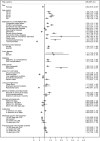Risk factors for hospital admission in the 28 days following a community-acquired pneumonia diagnosis in older adults, and their contribution to increasing hospitalisation rates over time: a cohort study
- PMID: 26631055
- PMCID: PMC4679905
- DOI: 10.1136/bmjopen-2015-008737
Risk factors for hospital admission in the 28 days following a community-acquired pneumonia diagnosis in older adults, and their contribution to increasing hospitalisation rates over time: a cohort study
Abstract
Objectives: To determine factors associated with hospitalisation after community-acquired pneumonia (CAP) among older adults in England, and to investigate how these factors have contributed to increasing hospitalisations over time.
Design: Cohort study.
Setting: Primary and secondary care in England.
Population: 39,211 individuals from the Clinical Practice Research Datalink, who were eligible for linkage to Hospital Episode Statistics and mortality data, were aged ≥ 65 and had at least 1 CAP episode between April 1998 and March 2011.
Main outcome measures: The association between hospitalisation within 28 days of CAP diagnosis (a 'post-CAP' hospitalisation) and a wide range of comorbidities, frailty factors, medications and vaccinations. We examined the role of these factors in post-CAP hospitalisation trends. We also looked at trends in post-CAP mortality and length of hospitalisation over the study period.
Results: 14 comorbidities, 5 frailty factors and 4 medications/vaccinations were associated with hospitalisation (of 18, 12 and 7 considered, respectively). Factors such as chronic lung disease, severe renal disease and diabetes were associated with increased likelihood of hospitalisation, whereas factors such as recent influenza vaccination and a recent antibiotic prescription decreased the odds of hospitalisation. Despite adjusting for these and other factors, the average predicted probability of hospitalisation after CAP rose markedly from 57% (1998-2000) to 86% (2009-2010). Duration of hospitalisation and 28-day mortality decreased over the study period.
Conclusions: The risk factors we describe enable identification of patients at increased likelihood of post-CAP hospitalisation and thus in need of proactive case management. Our analyses also provide evidence that while comorbidities and frailty factors contributed to increasing post-CAP hospitalisations in recent years, the trend appears to be largely driven by changes in service provision and patient behaviour.
Keywords: EPIDEMIOLOGY; PUBLIC HEALTH.
Published by the BMJ Publishing Group Limited. For permission to use (where not already granted under a licence) please go to http://www.bmj.com/company/products-services/rights-and-licensing/
Figures

References
-
- Blunt I. Focus on preventable admissions: trends in emergency admissions for ambulatory care sensitive conditions, 2001 to 2013. London: The Health Foundation and The Nuffield Trust, 2013.
-
- NHS England. Avoiding unplanned admissions enhanced service: proactive case finding and care review for vulnerable people. Guidance and audit requirements. London: NHS England, The BMA and NHS Employers, 2014.
-
- BMA. Guide to avoiding unplanned admissions. http://bma.org.uk/practical-support-at-work/contracts/gp-contracts-and-f... (accessed 04 Feb 2015).
Publication types
MeSH terms
Grants and funding
LinkOut - more resources
Full Text Sources
Other Literature Sources
Medical
Miscellaneous
